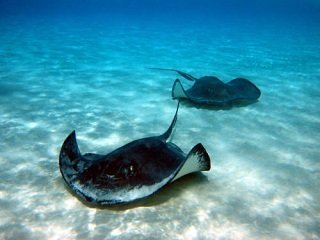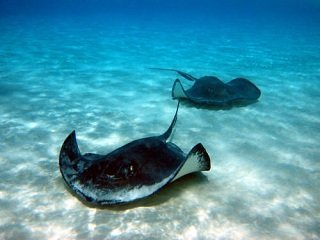 Standing knee deep in the crystal clear waters of a stretch of saltwater while casting a line out has got to be one of the most enjoyable fishing experiences one can have. However, the ocean is a bit different than freshwater, and is home to potentially harmful species like sharks, jellyfish, and stingrays. While you’re more likely to step on a piece of glass or a rusty fish hook than you are to be stung by a ray, it’s still important to be prepared for such an encounter. Today I’ve outlined some tips to help you employ basic first aid should you or anyone you know be stung while out on the flats.
Standing knee deep in the crystal clear waters of a stretch of saltwater while casting a line out has got to be one of the most enjoyable fishing experiences one can have. However, the ocean is a bit different than freshwater, and is home to potentially harmful species like sharks, jellyfish, and stingrays. While you’re more likely to step on a piece of glass or a rusty fish hook than you are to be stung by a ray, it’s still important to be prepared for such an encounter. Today I’ve outlined some tips to help you employ basic first aid should you or anyone you know be stung while out on the flats.
Stingrays are ambush predators and will bury themselves in the sandy ocean bottom, lying in wait for prey to pass by. This makes them invisible to us as we walk around in the surf. When disturbed or stepped on, a stingray will instinctively whip its tail—armed with serrated, venomous spines that can puncture the soles of shoes—in defense of its own safety, resulting in quite a painful sting.
Small rays deliver a mildly painful sting that endures for a few hours. However, stings from larger rays require a trip to the hospital. To immediately alleviate the pain, it’s best to immerse the sting site in very hot water. This will neutralize the pain and, after an hour or so in hot water (be sure to not let it cool), the venom will run its course and the swelling will go down. Also, keep meat tenderizer on hand if you fish saltwater often and are prone to wading, as it will help when applied directly to the wound.
There are a few tell-tale signs to decipher whether you’ve been stung or you’ve just stepped on a piece of glass. Pain will start immediately and only intensify over the first hour. Also, because the venom affects your cardiovascular system, your extremities will turn white or red, depending on how your blood reacts. In serious cases, the effects of the venom on your heart can be so severe that they cause the heart to beat extremely irregularly or even stop beating altogether.
Like most wildlife encounters, situations such as this are a result of intrusion into the rays’ habitat. Take measures to prevent against stings by shuffling your feet when wading and being mindful of where you’re fishing. While some stings are minor and the aforementioned tips help against the pain, it’s still smart to go to the hospital if you’re stung, just as a precaution against an unknown allergy, barb removal, or infection. Not only that, stingray venom affects your heart and cardiovascular system, which may require medication in order to counteract any irregular affects. Stingray encounters are inevitable, but the presence of rays indicates that you’re fishing in the right area, which is a good sign. Just remember to be conscious of where you stand and keep some meat tenderizer on hand and you’ll be in good shape.








